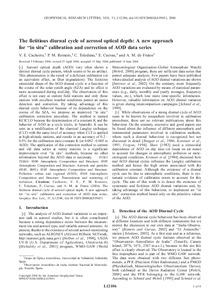Por favor, use este identificador para citar o enlazar este ítem:
http://hdl.handle.net/20.500.11765/2378
The fictitious diurnal cycle of aerosol optical depth: A new approach for “in situ” calibration and correction of AOD data series
Registro completo de metadatos
| Campo DC | Valor | Lengua/Idioma |
|---|---|---|
| dc.contributor.author | Cachorro, Victoria E. | es_ES |
| dc.contributor.author | Romero Campos, Pedro Miguel | es_ES |
| dc.contributor.author | Toledano, Carlos | es_ES |
| dc.contributor.author | Cuevas Agulló, Emilio | es_ES |
| dc.contributor.author | Frutos Baraja, Ángel Máximo de | es_ES |
| dc.date.accessioned | 2016-05-06T06:30:33Z | - |
| dc.date.available | 2016-05-06T06:30:33Z | - |
| dc.date.issued | 2004 | - |
| dc.identifier.citation | Geophysical Research Letters. 2004, 31(12), p. L12106 | es_ES |
| dc.identifier.issn | 0094-8276 | - |
| dc.identifier.issn | 1944-8007 | - |
| dc.identifier.uri | http://hdl.handle.net/20.500.11765/2378 | - |
| dc.description.abstract | Aerosol optical depth (AOD) very often shows a distinct diurnal cycle pattern, which seems to be an artifact. This phenomenon is the result of a deficient calibration (or an equivalent effect, as filter degradation). The fictitious sinusoidal shape of the AOD diurnal cycle is a function of the cosine of the solar zenith angle (SZA) and its effect is more accentuated during mid-day. The observation of this effect is not easy at current field stations and only those stations with excellent weather conditions permit an easier detection and correction. By taking advantage of this diurnal cycle behavior because of its dependence on the cosine of the SZA, we propose an improved “in situ” calibration correction procedure. The method is named KCICLO because the determination of a constant K and the behavior of AOD as a cycle (ciclo, in Spanish). It can be seen as a modification of the classical Langley technique (CLT) with the same level of accuracy when CLT is applied at high-altitude stations, and results in an accuracy of 0.2–0.5% for the calibration ratio constant K (or 0.002–0.005 in AOD). The application of this correction method to current and old data series at sunny stations is a significant improvement over “in situ” methods, because no other information beyond the AOD data is necessary. | es_ES |
| dc.format | application/pdf | |
| dc.language.iso | eng | es_ES |
| dc.publisher | American Geophysical Union | es_ES |
| dc.subject | Aerosol optical depth | es_ES |
| dc.subject | Diurnal cycle | es_ES |
| dc.subject | Solar zenith angle | es_ES |
| dc.subject | Langley technique | es_ES |
| dc.title | The fictitious diurnal cycle of aerosol optical depth: A new approach for “in situ” calibration and correction of AOD data series | es_ES |
| dc.type | info:eu-repo/semantics/article | es_ES |
| dc.relation.publisherversion | https://dx.doi.org/10.1029/2004GL019651 | es_ES |
| dc.rights.accessRights | info:eu-repo/semantics/openAccess | es_ES |
| Colecciones: | Artículos científicos 2000-2004 | |
Ficheros en este ítem:
| Fichero | Descripción | Tamaño | Formato | ||
|---|---|---|---|---|---|
| Cachorro_2004-GRSL.pdf | 138,41 kB | Adobe PDF |  Visualizar/Abrir |
Los ítems de Arcimis están protegidos por una Licencia Creative Commons, salvo que se indique lo contrario.





